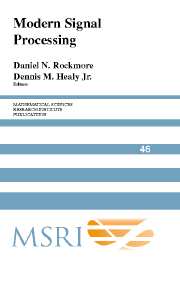Refine search
Actions for selected content:
1004 results in Computational statistics, machine learning and information science

Modern Signal Processing
-
- Published online:
- 25 June 2025
- Print publication:
- 05 April 2004

Bibliography and Modern Book Production
- Notes and Sources for Student Librarians, Printers, Booksellers, Stationers, Book-collectors
-
- Published by:
- Wits University Press
- Published online:
- 17 April 2025
- Print publication:
- 01 August 2024
Appendix B - Advanced Topics in Classification Metrics
- from Appendices
-
- Book:
- Machine Learning Evaluation
- Published online:
- 07 November 2024
- Print publication:
- 21 November 2024, pp 373-386
-
- Chapter
- Export citation
Contents
-
- Book:
- Machine Learning Evaluation
- Published online:
- 07 November 2024
- Print publication:
- 21 November 2024, pp vii-x
-
- Chapter
- Export citation
12 - Conclusion
- from Part IV - Evaluation from a Practical Perspective
-
- Book:
- Machine Learning Evaluation
- Published online:
- 07 November 2024
- Print publication:
- 21 November 2024, pp 342-358
-
- Chapter
- Export citation
Appendices
-
- Book:
- Machine Learning Evaluation
- Published online:
- 07 November 2024
- Print publication:
- 21 November 2024, pp 359-360
-
- Chapter
- Export citation
Dedication
-
- Book:
- Machine Learning Evaluation
- Published online:
- 07 November 2024
- Print publication:
- 21 November 2024, pp v-vi
-
- Chapter
- Export citation
Index
-
- Book:
- Machine Learning Evaluation
- Published online:
- 07 November 2024
- Print publication:
- 21 November 2024, pp 403-408
-
- Chapter
- Export citation
Acknowledgments
-
- Book:
- Machine Learning Evaluation
- Published online:
- 07 November 2024
- Print publication:
- 21 November 2024, pp xvii-xviii
-
- Chapter
- Export citation
4 - Traditional Machine Learning Evaluation
- from Part I - Preliminary Considerations
-
- Book:
- Machine Learning Evaluation
- Published online:
- 07 November 2024
- Print publication:
- 21 November 2024, pp 51-80
-
- Chapter
- Export citation
Part III - Evaluation for Other Settings
-
- Book:
- Machine Learning Evaluation
- Published online:
- 07 November 2024
- Print publication:
- 21 November 2024, pp 209-210
-
- Chapter
- Export citation
6 - Resampling
- from Part II - Evaluation for Classification
-
- Book:
- Machine Learning Evaluation
- Published online:
- 07 November 2024
- Print publication:
- 21 November 2024, pp 128-153
-
- Chapter
- Export citation
2 - Statistics Overview
- from Part I - Preliminary Considerations
-
- Book:
- Machine Learning Evaluation
- Published online:
- 07 November 2024
- Print publication:
- 21 November 2024, pp 8-32
-
- Chapter
- Export citation
Part I - Preliminary Considerations
-
- Book:
- Machine Learning Evaluation
- Published online:
- 07 November 2024
- Print publication:
- 21 November 2024, pp 1-2
-
- Chapter
- Export citation
Appendix A - Statistical Tables
- from Appendices
-
- Book:
- Machine Learning Evaluation
- Published online:
- 07 November 2024
- Print publication:
- 21 November 2024, pp 361-372
-
- Chapter
- Export citation
Preface
-
- Book:
- Machine Learning Evaluation
- Published online:
- 07 November 2024
- Print publication:
- 21 November 2024, pp xv-xvi
-
- Chapter
- Export citation
Abbreviations
-
- Book:
- Machine Learning Evaluation
- Published online:
- 07 November 2024
- Print publication:
- 21 November 2024, pp xi-xiv
-
- Chapter
- Export citation
10 - Industrial-Strength Evaluation
- from Part IV - Evaluation from a Practical Perspective
-
- Book:
- Machine Learning Evaluation
- Published online:
- 07 November 2024
- Print publication:
- 21 November 2024, pp 289-307
-
- Chapter
- Export citation
5 - Metrics
- from Part II - Evaluation for Classification
-
- Book:
- Machine Learning Evaluation
- Published online:
- 07 November 2024
- Print publication:
- 21 November 2024, pp 83-127
-
- Chapter
- Export citation
3 - Machine Learning Preliminaries
- from Part I - Preliminary Considerations
-
- Book:
- Machine Learning Evaluation
- Published online:
- 07 November 2024
- Print publication:
- 21 November 2024, pp 33-50
-
- Chapter
- Export citation
